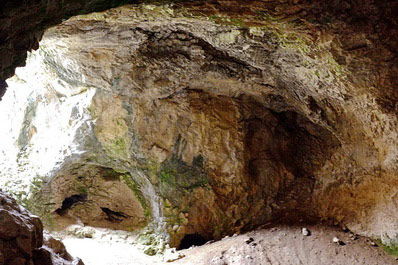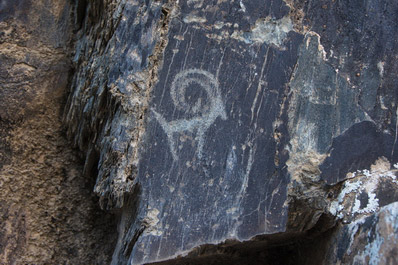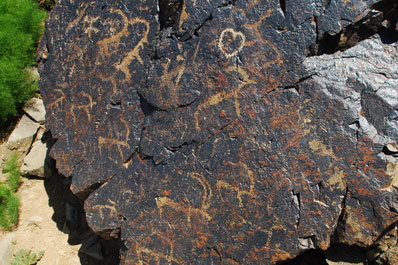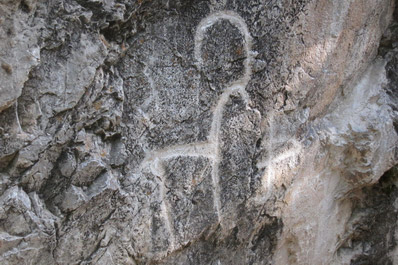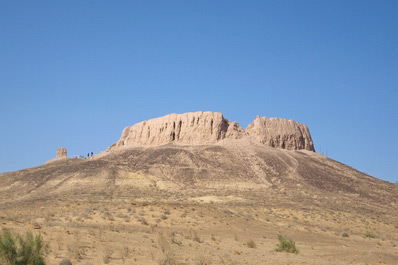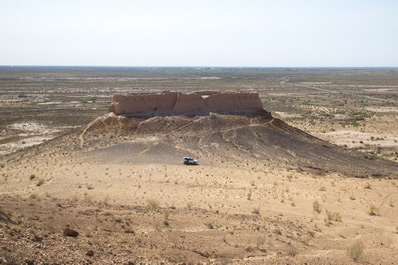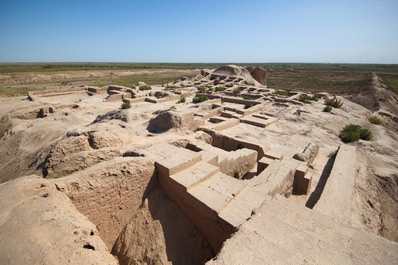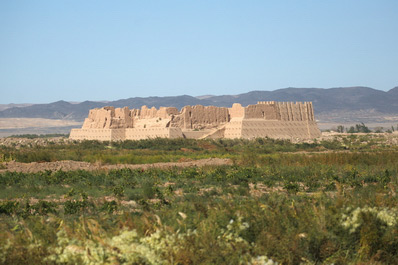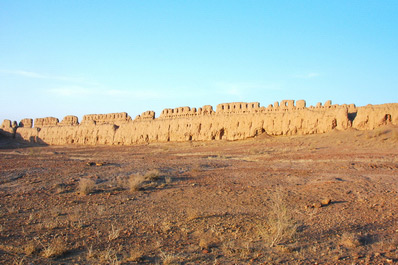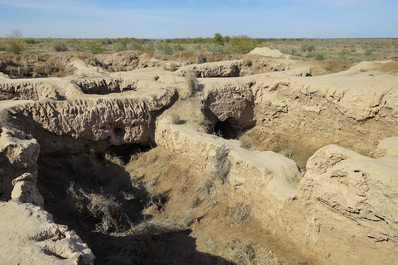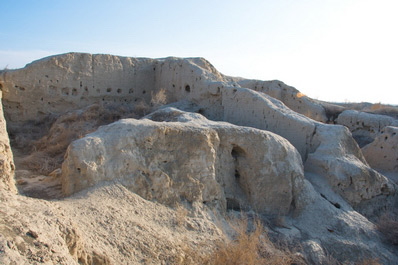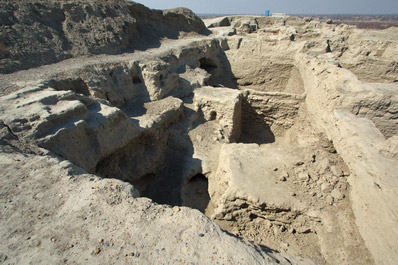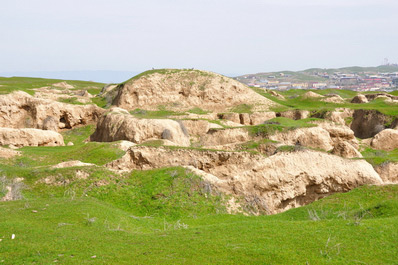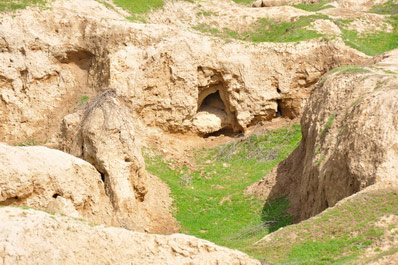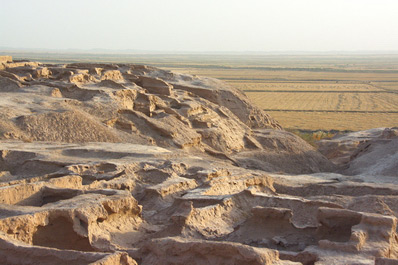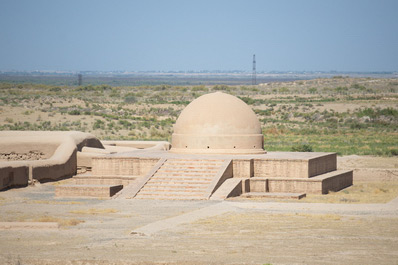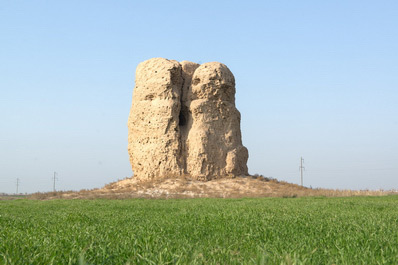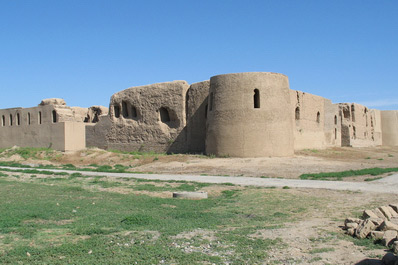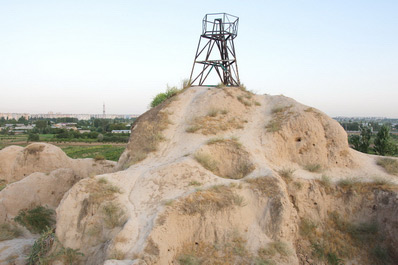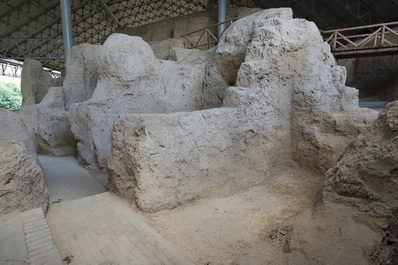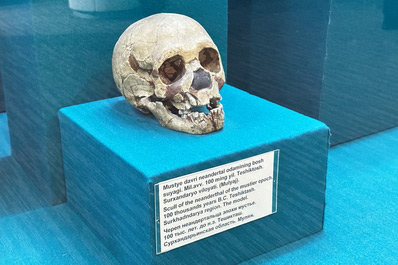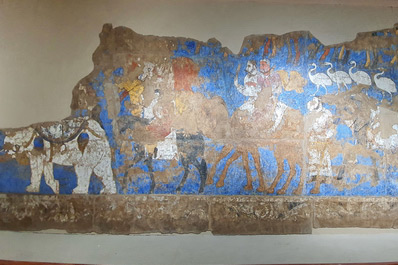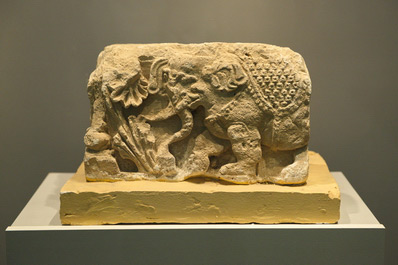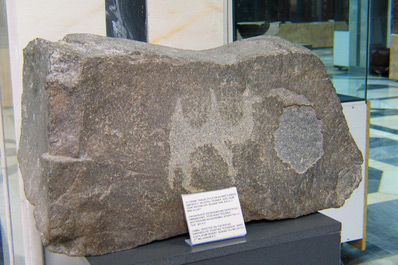Archaeology of Uzbekistan
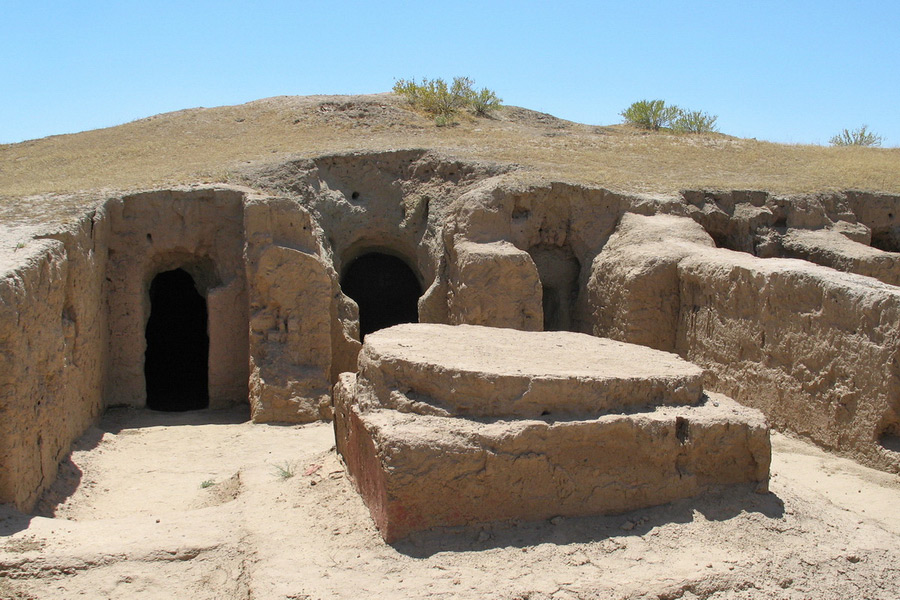
The first settlements in Uzbekistan appeared tens or even hundreds of thousands of years ago. The region is rich in archaeological finds from that time, including Neanderthal remains over 40,000 years old and ancient petroglyphs dating back 17,000 years. About 3,000 years ago, the first civilizations began to emerge, eventually forming ancient Khorezm, Paikend, and the fortresses of the Bukhara oasis. Cities like Samarkand, Bukhara, Khiva, and Termez also developed during this period.
Uzbekistan boasts thousands of archaeological finds, and you can learn about many of them in this text.
Primitive People
The Teshik-Tash Grotto in the Surkhandarya region is world-famous. In the 1930s, the remains of a Neanderthal girl were discovered here.
Another notable site is the Obi-Rahmat Grotto near the Charvak reservoir, where archaeologists found the remains of a boy who may be either Neanderthal or Cro-Magnon. These remains are at least 50,000 years old.
The Sarmyshsai Gorge in the Navoi region is home to over 5,000 rock paintings. The earliest date back to the Mesolithic Age (15,000-6,000 B.C.), with most from the Bronze Age (3,000-900 B.C.).
In Beldersay, ancient rock paintings have also been found, dating from the VIII millennium BC to the IV millennium BC. These petroglyphs are located at an altitude of 2,450 meters above sea level.
The village of Khojikent, near the Charvak reservoir, is another site with ancient petroglyphs, with the oldest dating back to the IV-III millennia BC.
Antiquity and Early Middle Ages
Many ancient fortresses and cities over 2,500 years old are scattered across Uzbekistan. Initially, Zoroastrianism was practiced in these lands, followed by the arrival of Buddhist missionaries from India. Numerous cities flourished along the Amu Darya, Syr Darya, and Zeravshan rivers. Alexander the Great even established two cities here: Alexandria Eskhat on the Syr Darya and Alexandria Oxiana on the Amu Darya.
Ancient Khorezm
In modern Karakalpakstan, part of ancient Khorezm, you'll find several fortresses and the ancient dakhma Chilpyk (Shilpyk), a Zoroastrian burial tower over 2,000 years old. Bodies were placed at the top for birds and the sun to leave only bones, which were then stored in ossuaries. Several such vessels have been found around the dakhma.
Ayaz-Kala is a complex of three fortresses built in the III-II centuries BC to protect against nomadic raids. Today, Ayaz-Kala stands isolated in the desert.
The Toprak-Kala fortress, constructed in the 1st century, later became the capital of ancient Khorezm. It housed a palace and residential quarters. Archaeological excavations uncovered documents written on plaques, leather, and sticks, including a list of free men and slaves. For unknown reasons, Toprak-Kala was abandoned in the 5th century.
Kyzyl-Kala is an ancient outpost near Toprak-Kala, with varying estimates of its age, ranging from the II-I centuries BC to the I-II centuries. The fortress has two floors and remnants of towers on both sides.
Another Khorezm settlement, Janbas-Kala, appeared between the IV century BC and the 1st century. About 2,000 people lived there, engaging in agriculture and cattle breeding. One found building might have been a Zoroastrian fire temple.
Koy-Krylgan-Kala fortress, built in the IV-III centuries BC, is thought to have housed either a Zoroastrian fire temple or a khan's tomb.
Paikend is one of the oldest cities near Bukhara, with the first settlement appearing in the 3rd century BC. Many medieval artifacts have been preserved there.
The palace in the town of Varakhsha, near Bukhara, dates back to at least the 5th century BC. Archaeologists have uncovered ancient paintings in the Red and Western Halls of the palace.
Vardanzi, an ancient city founded in the 5th century, was located 40 kilometers from modern Bukhara. It was once home to rulers and a hub for trade with neighboring regions.
In Bukhara itself, archaeologists found fragments of ceramic products with chandelier paintings, remnants of a traditional Bukhara bath, silver coins from the 3rd-2nd centuries BC, glassware from the 10th-11th centuries, medieval manuscripts from the 10th and 13th centuries, ceramic dishes, and many other items.
Afrasiab is an ancient settlement in Samarkand, first mentioned in the 8th century BC. It was once a major trade and cultural center known throughout Central Asia. Afrasiab is actually the ruins of old Samarkand, destroyed by the Mongols in 1220. The new Samarkand was built nearby.
During excavations at Afrasiab, hundreds of unique items were found, including coins, ossuaries, terracotta statuettes, jewelry, ceramic dishes, wall paintings, and more. Archaeologists also discovered remains of a citadel, palace, and residential and handicraft quarters from the 6th-7th centuries.
Kampyr-tepa is an ancient fortress and the most studied site of its kind in Central Asia. Founded in the 4th century BC, it was initially thought to be a small city from the Kushan Kingdom era (1st century), but earlier artifacts were found during excavations. Discoveries include pottery, jewelry, manuscripts, and more. Academician Edward Rtveladze, who discovered Kampyr-tepa in 1972, concluded it was the port city founded by Alexander the Great, known as Alexandria of Oxiana.
Fayaz-tepa revealed a Buddhist monastery similar to those in Pakistan, India, and Afghanistan. The monastery had religious, dormitory, and economic sections. Finds include parts of an altar, clay vessels with images of men, and the famous sculpture-triad with Buddha. A nearby stupa and ancient Buddha images on the monastery walls are among the oldest in Central Asia. Interestingly, pagan artifacts like the head of the sun god and a mural of a deity with horns were also found here.
Kara Tepe Fortress, or "black hill", located 800 meters from Fayaz Tepe, was home to a Buddhist monastery founded in the 1st century. It fell into disrepair in the 4th century and later housed a Christian monastery in the 8th century. Archaeological finds include stupas, sculptures, a ceramic vessel with an inscription, and six skulls, one of which belonged to a child.
The Zurmala stupa, another significant Buddhist monument in Termez, was built with over a million bricks and stands 16 meters high. Archaeologists believe it was erected in the 1st-2nd century, like other Buddhist buildings in the area.
The Kyrk-kyz fortress, built in either the early centuries AD or the 9th century, remains a mystery. According to legend, 40 brave girls (“Kyrk” means forty, “Kyz” means girl) defended themselves against invaders here.
Dalverzin-tepa, one of the most famous ancient settlements in southern Uzbekistan, was founded no later than the 2nd-1st century BC. By the 1st-3rd centuries, it was a large trade and handicraft city, part of the Kushan kingdom, but declined by the 4th century. Excavations uncovered Buddha's head, jugs, ivory products, the head of a Kushan prince from the 1st-2nd centuries, bone blanks for combs, pottery, remains of a Buddhist temple, jewelry, and a treasure trove of precious metals. Archaeologists also found 2nd-century chess pieces, considered the oldest in the world.
The ancient settlement of Shosh-tepa (Shash-tepa) is located in the southwestern part of Tashkent, covering 25 hectares. Today, only a portion of the 12-meter-high citadel remains. Archaeological finds from the 3rd century BC helped determine Tashkent's age, leading to its 2200th anniversary celebration in 2009.
Ming-urik (Minguryuk) is another ancient site in Tashkent, near the central station. Evidence shows that in the 1st century, this was the capital of Chach. The city spanned over 4 kilometers and was fortified with strong walls. It housed a ruler's palace with four towers, a Zoroastrian temple, and residential areas. The city thrived with jewelers, blacksmiths, artists, and ceramists until it was destroyed in the early 8th century during the Arab conquests.
In the northeastern part of Tashkent lies Ak-tepa (Aktepa). This settlement existed as early as the 5th century and covered 100 hectares. It is believed to have been the site of a summer palace for one of Chach's viceroys. Though the city was largely destroyed by fire during the Arab conquests, some buildings lasted until the 13th century. Excavations have unearthed rooms from a Zoroastrian temple complex with a sanctuary and fire altar, as well as pottery fragments, weapons, jewelry, coins, and more.
Fergana Valley
The small town of Chust in the Namangan region is one of Uzbekistan's most significant archaeological sites. The Bronze Age culture discovered here, named after the town, dates back to the 2nd-3rd millennia BC. The Chust culture was known for its sedentary agricultural lifestyle. Archaeological finds include stone tools, pottery with human and animal images, burials, earthen walls, sickle-shaped stone knives, metal daggers, hearth remnants, grain grinders, loom parts, bone products, and more.
Akhsiket (Akhsiket, Akhsikent) was once the largest and most renowned city in the Fergana Valley and the capital of Fergana. Founded in the 3rd-2nd centuries BC, it was destroyed by the Chingizids in the early 13th century. Rebuilt over the next two centuries, Akhsiket was again destroyed by an earthquake in 1620. Excavations revealed a citadel with a palace and prison, a mosque, and artisans' quarters. Finds include pottery, glassware, large vessels with images of people, pomegranates, camels, and thousands of refractory pots used for metal melting.
Kuva is another ancient city in the Fergana Valley, founded no later than the 3rd century BC. In the 1950s, 33 archaeological sites were discovered in the Kuva district, with the earliest, such as Chillya-mazar, Chiltan-tepe, and Kosh-tepe, dating back to the 1st century BC. Kuva, formerly known as Kuba, became a large feudal city by the 8th century, featuring a citadel, shahristan, and craft quarters by the 10th century. Excavations have uncovered ossuary fragments, arrowheads, pottery, jars, candle stands, remains of a 7th-century Buddhist temple, and more.
Archaeological Finds in Museums of Uzbekistan
Many of the ancient cities mentioned in this article haven’t survived to the present day. While there were few losses in the late Middle Ages, most mosques, madrasas, and fortresses from that era have been reconstructed and still stand today. The most significant artifacts have changed hands over the years and are now housed in museums around the world and in Uzbekistan.
Uzbekistan's cultural heritage can be found in museums in the United Kingdom, Germany, India, Italy, Canada, Malaysia, Poland, Russia, the United States, Turkey, France, the Czech Republic, Japan, and more. For instance, the Miho Museum in Japan showcases items from Uzbekistan dating from the end of the 3rd to the beginning of the 2nd millennium BC. Moscow features exhibits from ancient Khorezm and Northern Bactria (4th century BC - 4th century AD). In New Delhi, you can see jewelry made in present-day Uzbekistan from the turn of the 1st century BC and the 1st century AD.
To see some of the most fascinating archaeological exhibits within Uzbekistan, check out these museums:
State Museum of History of Uzbekistan, Tashkent
One of the oldest museums in Central Asia, founded in 1876, it boasts over 250,000 exhibits. The oldest artifacts are 1.5 million years old, including primitive human remains. The museum houses a diverse collection of items discovered in ancient settlements like Dalverzin-tepa, Afrasiab, Khalchayan, and Koktepa. Numismatists will appreciate the collection of coins dating back to the 5th century BC.
Founded in 1970, this museum is near the Afrasiab settlement, which existed in the 8th century BC. It contains historical and archaeological artifacts such as fragments of defensive walls, ossuaries, coins, pottery, weapons, and more. The museum also features fresco fragments from the 7th-8th centuries depicting hunting scenes and festivals.
Bukhara State Architectural and Art Museum-Reserve
Located in the Ark Fortress, this museum holds unique exhibits. The fortress walls themselves are an architectural and historical marvel. Once home to about 3,000 people, the Ark was repeatedly destroyed and rebuilt. Today, it houses thousands of exhibits from sites like Varakhshi and Paikend.
Khiva
Archaeological exhibits in Khiva are spread across several locations. The Al-Khwarizmi and Beruni Museum of the History of Khorezm houses finds from the Tash-Khovli Palace and artifacts from Toprak-Kala and Koy-Krylgan-Kala. The Kazy-Kalyan Madrasah showcases medieval ceramics, wooden items, copper artifacts, and jewelry.
Ideal for fans of ancient history, this museum's earliest exhibits date back to the Stone Age. It features a rich collection of artifacts from ancient times, the Greek-Bactrian period, the Kushan Kingdom, and later eras. Many exhibits related to Buddhism were also found in Termez, and the museum's storerooms hold over 27,000 items.
Famous for its rich collection of paintings, this museum also boasts many ancient artifacts. The antiquities were the foundation of the museum, thanks to Savitsky's participation in archaeological expeditions in Karakalpakstan during the 1950s. The earliest exhibit, a rock drawing of a camel, dates back to the 2nd millennium BC. Savitsky also collected ancient jewelry.
Local history museums in cities like Kokand and Andijan also feature interesting exhibits on the history of the Fergana Valley.
Uzbekistan is home to many ancient cities and settlements. Take a tour through these historic sites to imagine how life was centuries ago, then visit the museums to see the artifacts uncovered by archaeologists.


